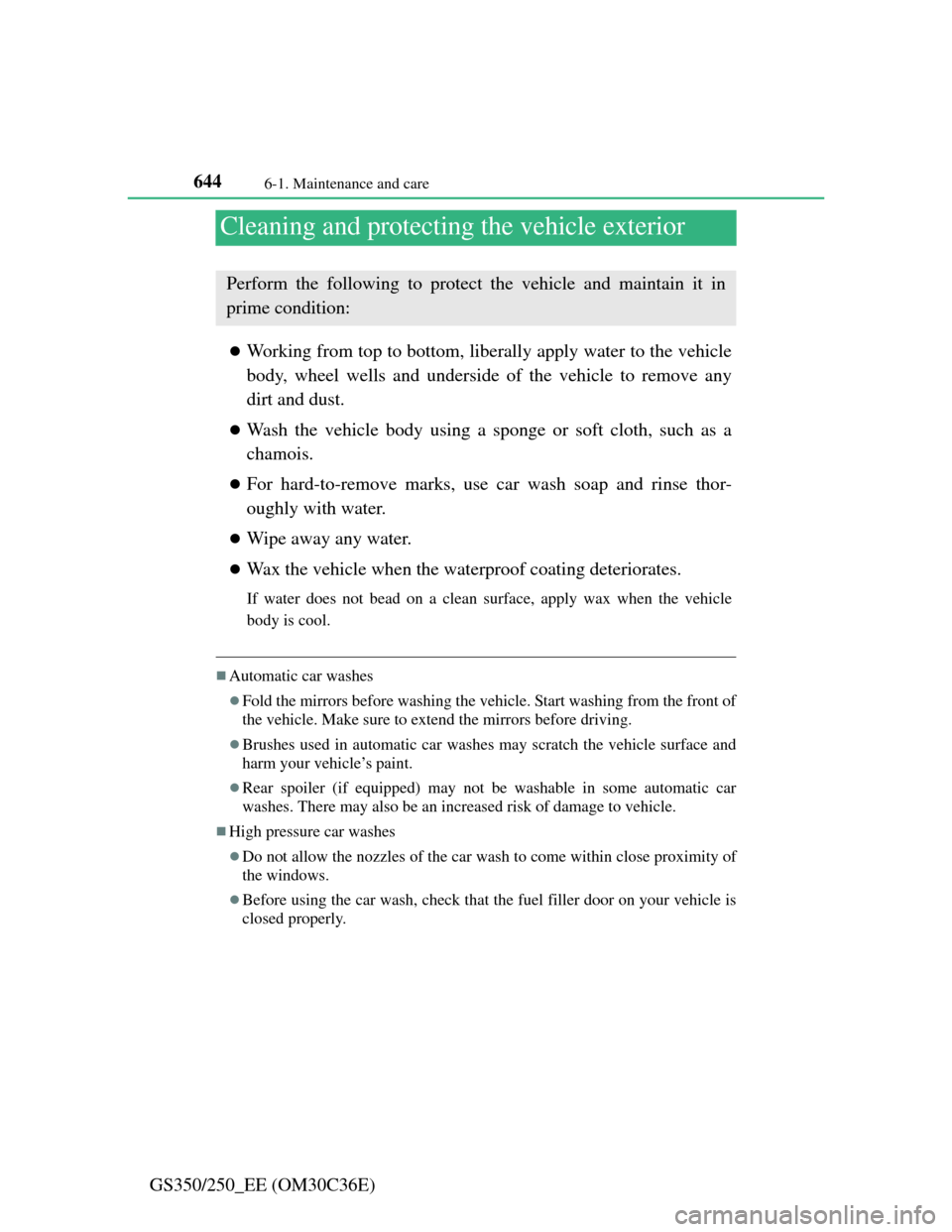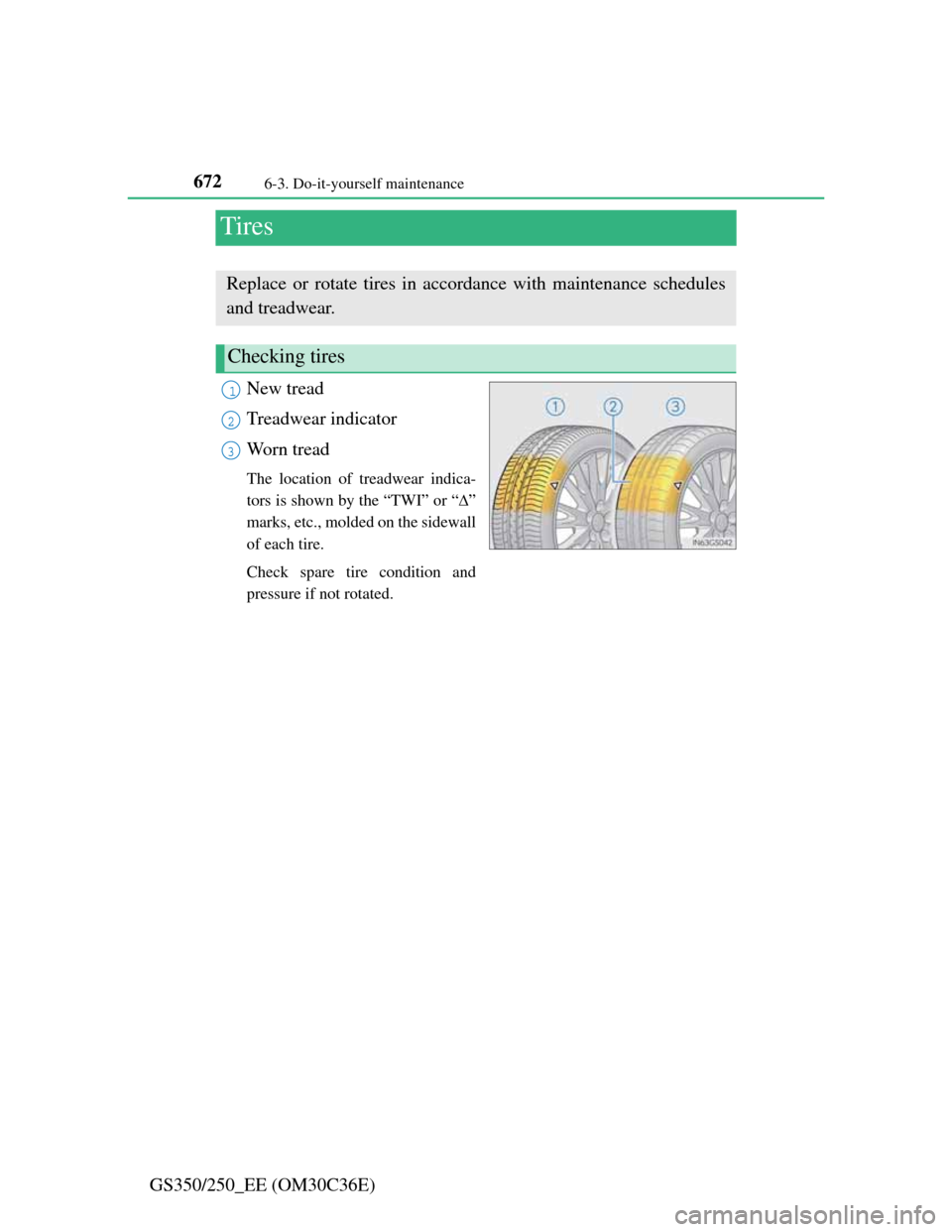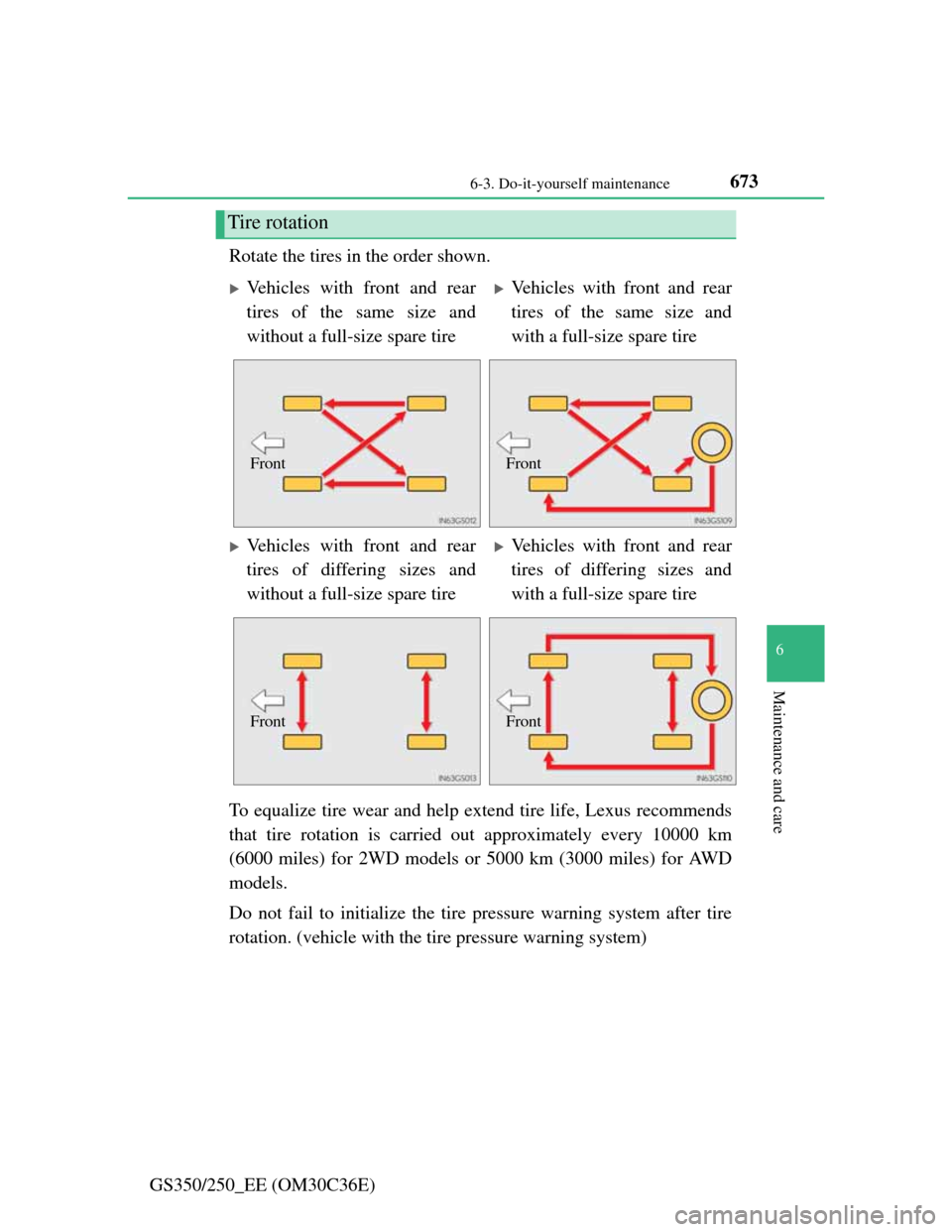Pressure Lexus GS350 2012 Owner's Guide
[x] Cancel search | Manufacturer: LEXUS, Model Year: 2012, Model line: GS350, Model: Lexus GS350 2012Pages: 914, PDF Size: 49.39 MB
Page 661 of 914

643
6Maintenance and care
GS350/250_EE (OM30C36E)
6-1. Maintenance and care
Cleaning and protecting
the vehicle exterior ......... 644
Cleaning and protecting
the vehicle interior .......... 648
6-2. Maintenance
Maintenance
requirements ................... 651
6-3. Do-it-yourself maintenance
Do-it-yourself service
precautions...................... 654
Hood ................................. 657
Positioning a floor jack ..... 658
Engine compartment ......... 660
Tires .................................. 672
Tire inflation pressure ....... 689
Wheels .............................. 691
Air conditioning filter ....... 693
Electronic key battery ....... 695
Checking and replacing
fuses ................................ 698
Light bulbs ........................ 720
Page 662 of 914

6446-1. Maintenance and care
GS350/250_EE (OM30C36E)
Cleaning and protecting the vehicle exterior
Working from top to bottom, liberally apply water to the vehicle
body, wheel wells and underside of the vehicle to remove any
dirt and dust.
Wash the vehicle body using a sponge or soft cloth, such as a
chamois.
For hard-to-remove marks, use car wash soap and rinse thor-
oughly with water.
Wipe away any water.
Wax the vehicle when the waterproof coating deteriorates.
If water does not bead on a clean surface, apply wax when the vehicle
body is cool.
Automatic car washes
Fold the mirrors before washing the vehicle. Start washing from the front of
the vehicle. Make sure to extend the mirrors before driving.
Brushes used in automatic car washes may scratch the vehicle surface and
harm your vehicle’s paint.
Rear spoiler (if equipped) may not be washable in some automatic car
washes. There may also be an increased risk of damage to vehicle.
High pressure car washes
Do not allow the nozzles of the car wash to come within close proximity of
the windows.
Before using the car wash, check that the fuel filler door on your vehicle is
closed properly.
Perform the following to protect the vehicle and maintain it in
prime condition:
Page 673 of 914

655 6-3. Do-it-yourself maintenance
6
Maintenance and care
GS350/250_EE (OM30C36E)
Light bulbs (P. 722)
• Bulb with same number and watt-
age rating as original
• Phillips-head screwdriver
• Flathead screwdriver
•Wrench
Radiator and condenser (P. 667)
Tire inflation pressure (P. 691)• Tire pressure gauge
• Compressed air source
Wa s h e r f l u i d (P. 671)
• Water or washer fluid containing
antifreeze (for winter use)
• Funnel (used only for adding
water or washer fluid)
CAUTION
The engine compartment contains many mechanisms and fluids that may
move suddenly, become hot, or become electrically energized. To avoid death
or serious injury, observe the following precautions.
When working on the engine compartment
Keep hands, clothing and tools away from the moving fan and engine
drive belt.
Be careful not to touch the engine, radiator, exhaust manifold, etc. right
after driving as they may be hot. Oil and other fluids may also be hot.
Do not leave anything that may burn easily, such as paper and rags, in the
engine compartment.
Do not smoke, cause sparks or expose an open flame to fuel or the battery.
Fuel and battery fumes are flammable.
Be extremely cautious when working on the battery. It contains poisonous
and corrosive sulfuric acid.
Take care because brake fluid can harm your hands or eyes and damage
painted surfaces. If fluid gets on your hands or in your eyes, flush the
affected area with clean water immediately.
If you still experience discomfort, consult a doctor.
ItemsParts and tools
Page 684 of 914

6666-3. Do-it-yourself maintenance
GS350/250_EE (OM30C36E)
CAUTION
When the engine is hot
Do not remove the engine coolant reservoir cap or the radiator cap. (P.
830)
The cooling system may be under pressure and may spray hot coolant if the
cap is removed, causing serious injuries, such as burns.
NOTICE
When adding coolant
Coolant is neither plain water nor straight antifreeze. The correct mixture of
water and antifreeze must be used to provide proper lubrication, corrosion
protection and cooling. Be sure to read the antifreeze or coolant label.
If you spill coolant
Be sure to wash it off with water to prevent it from damaging parts or paint.
Page 690 of 914

6726-3. Do-it-yourself maintenance
GS350/250_EE (OM30C36E)
Tires
New tread
Treadwear indicator
Worn tread
The location of treadwear indica-
tors is shown by the “TWI” or “”
marks, etc., molded on the sidewall
of each tire.
Check spare tire condition and
pressure if not rotated.
Replace or rotate tires in accordance with maintenance schedules
and treadwear.
Checking tires
1
2
3
Page 691 of 914

673 6-3. Do-it-yourself maintenance
6
Maintenance and care
GS350/250_EE (OM30C36E)Rotate the tires in the order shown.
To equalize tire wear and help extend tire life, Lexus recommends
that tire rotation is carried out approximately every 10000 km
(6000 miles) for 2WD models or 5000 km (3000 miles) for AWD
models.
Do not fail to initialize the tire pressure warning system after tire
rotation. (vehicle with the tire pressure warning system)
Tire rotation
Vehicles with front and rear
tires of the same size and
without a full-size spare tireVehicles with front and rear
tires of the same size and
with a full-size spare tire
Vehicles with front and rear
tires of differing sizes and
without a full-size spare tireVehicles with front and rear
tires of differing sizes and
with a full-size spare tire
FrontFront
FrontFront
Page 692 of 914

6746-3. Do-it-yourself maintenance
GS350/250_EE (OM30C36E)Your vehicle is equipped with a tire pressure warning system that
uses tire pressure warning valves and transmitters to detect low tire
inflation pressure before serious problems arise.
Vehicles without the tire inflation pressure display function
If the tire pressure drops below a predetermined level, the driver is
warned by a warning light. (P. 753)
Vehicles with the tire inflation pressure display function
If the tire pressure drops below a predetermined level, the driver
is warned by a screen display and a warning light. (P. 772)
The tire pressure detected by the tire pressure warning system
can be displayed on the multi-information display. (P. 106)
Installing tire pressure warning valves and transmitters
When replacing tires or wheels, tire pressure warning valves and
transmitters must also be installed.
When new tire pressure warning valves and transmitters are
installed, new ID codes must be registered in the tire pressure
warning computer and the tire pressure warning system must be
initialized. Have tire pressure warning valve and transmitter ID
codes registered by any authorized Lexus dealer or repairer, or
another duly qualified and equipped professional. (P. 676)
Tire pressure warning system (if equipped)
Page 693 of 914

675 6-3. Do-it-yourself maintenance
6
Maintenance and care
GS350/250_EE (OM30C36E)
Initializing the tire pressure warning system
The tire pressure warning system must be initialized in the fol-
lowing circumstances:
When rotating the tires.
When the tire inflation pressure is changed such as when
changing traveling speed.
When the tire pressure warning system is initialized, the current
tire inflation pressure is set as the benchmark pressure.
How to initialize the tire pressure warning system
Park the vehicle in a safe place and turn the engine switch off.
Initialization cannot be performed while the vehicle is moving.
Adjust the tire inflation pressure to the specified cold tire infla-
tion pressure level. (P. 850)
Make sure to adjust the tire pressure to the specified cold tire inflation
pressure level. The tire pressure warning system will operate based on
this pressure level.
Turn the engine switch to IGNITION ON mode.
1
2
3
Page 694 of 914

6766-3. Do-it-yourself maintenance
GS350/250_EE (OM30C36E)Press and hold the tire pres-
sure warning reset switch
until the tire pressure warn-
ing light blinks slowly 3
times.
Wait for a few minutes with the engine switch in IGNITION
ON mode and then turn the engine switch off.
Registering ID codes
The tire pressure warning valve and transmitter is equipped with
a unique ID code. When replacing a tire pressure warning valve
and transmitter, it is necessary to register the ID code. Have the
ID code registered by any authorized Lexus dealer or repairer, or
another duly qualified and equipped professional.
4
5
Page 695 of 914

677 6-3. Do-it-yourself maintenance
6
Maintenance and care
GS350/250_EE (OM30C36E)
When to replace your vehicle’s tires
Tires should be replaced if:
You have tire damage such as cuts, splits, cracks deep enough to expose the
fabric, and bulges indicating internal damage
A tire goes flat repeatedly or cannot be properly repaired due to the size or
location of a cut or other damage
If you are not sure, consult with any authorized Lexus dealer or repairer, or
another duly qualified and equipped professional.
Replacing tires and wheels (vehicles with the tire pressure warning system)
If the ID code of the tire pressure warning valve and transmitter is not regis-
tered, the tire pressure warning system will not work properly. After driving
for about 10 minutes, the tire pressure warning light blinks for 1 minute and
stays on to indicate a system malfunction.
Tire life
Any tire over 6 years old must be checked by a qualified technician even if it
has seldom or never been used or damage is not obvious.
Routine tire inflation pressure checks
The tire pressure warning system does not replace routine tire inflation pres-
sure checks. Make sure to check tire inflation pressure as part of your routine
of daily vehicle checks.
When rotating the tires (vehicles with the tire pressure warning system featur-
ing a tire inflation pressure display function)
Make sure that the engine switch is off. If the tires are rotated while the
engine switch is in IGNITION ON mode, the tire position information will
not be updated.
If this accidentally occurs, either turn the engine switch to off and then to
IGNITION ON mode, or initialize the system after checking that the tire
pressure is properly adjusted.